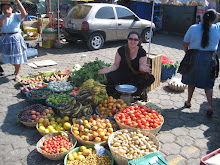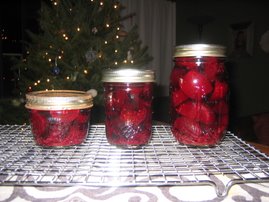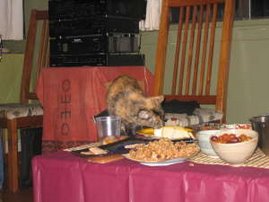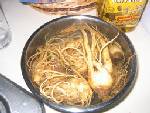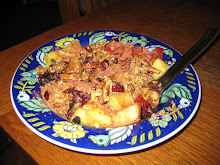 People really appreciate freshly-baked bread. You pop a loaf in the oven before guests arrive and the smell wafting from your kitchen will make people feel as welcome as anything. I've been experimenting with sourdough recipes since I brought my first starter back from San Francisco about three years ago. I've had a very hard time finding a recipe for a nice rustic loaf, but this one is the best so far. This recipe is from the King Arthur flour website, and it worked pretty well--it yields a nice crust and a chewy center. The problem that I've had is with the rising. I don't know if its the climate or what, but I rarely ever get the nice air pockets that characterize a good sourdough. I also have a hard time getting the loaves to rise high when I made free-form loaves; my dough seems to expand lengthwise, but not rise up. This time I used additional yeast toward the end of the process, and formed a lip of aluminum foil around the dough to keep it from expanding outward. This experiment makes me think that I ought to search for some spring-form dough ring for my next loaf.
People really appreciate freshly-baked bread. You pop a loaf in the oven before guests arrive and the smell wafting from your kitchen will make people feel as welcome as anything. I've been experimenting with sourdough recipes since I brought my first starter back from San Francisco about three years ago. I've had a very hard time finding a recipe for a nice rustic loaf, but this one is the best so far. This recipe is from the King Arthur flour website, and it worked pretty well--it yields a nice crust and a chewy center. The problem that I've had is with the rising. I don't know if its the climate or what, but I rarely ever get the nice air pockets that characterize a good sourdough. I also have a hard time getting the loaves to rise high when I made free-form loaves; my dough seems to expand lengthwise, but not rise up. This time I used additional yeast toward the end of the process, and formed a lip of aluminum foil around the dough to keep it from expanding outward. This experiment makes me think that I ought to search for some spring-form dough ring for my next loaf.I made two loaves in preparation for weekend guests. We served the freshly-baked loaves with a dinner of pan-seared venison, leeks, and sweet potatoes. The leftovers went well with pea soup for the next day's lunch, and toasted for tuna-salad sandwiches.
Rustic Supper Sourdough
1 cup "fed" sourdough starter
1 1/2 cups lukewarm water
2 teaspoons instant yeast
1 tablespoon sugar
2 1/2 teaspoons salt
5 cups flour
Combine all of the ingredients, kneading to form a smooth dough. Allow the dough to rise, in a covered bowl, until it's doubled in size, about 90 minutes. Gently divide the dough in half; it'll deflate somewhat. Shape the dough into two oval loaves--this is where I deviated from the recipe. I sprinkled a little bit of dried yeast and stretched it through the dough, folding it over and under itself until I had two smooth loaves. Place the loaves on a lightly greased baking sheet. Cover and let rise until very puffy, about 1 hour. Towards the end of the rising time, preheat the oven to 425°F. Spray the loaves with olive oil or lukewarm water. At this point, you can also do an egg wash to make the crust shiny. I didn't do that this time around. Make two fairly deep diagonal slashes in each. Bake the bread for 25 to 30 minutes, until it's a very deep golden brown. Remove it from the oven, and cool on a rack.


